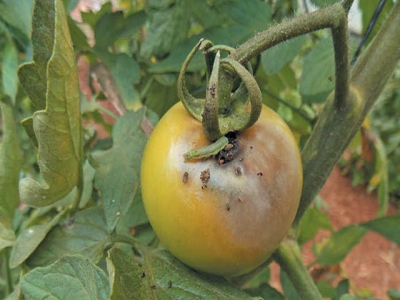Dealing with the African bollworm

The African bollworm (Helicoverpa armigera) has many host crops. The caterpillar, which is spiny when young, has a light stripe on the sides and usually turns green to match the foliage when older.
Bollworms escape into the fruit, where they are safe from pesticides. Photo: Bill Kerr
The adults are night-flying moths, the females being yellow to orange, and the males a greenish-grey.
One of the dangers of the bollworm is that it tends to appear sporadically, unlike, say, the cabbage pest Plutella spp, which gradually increases in number. Months can pass without any sign of bollworm, and then a sudden outbreak can occur.
This happens particularly after winter when the weather becomes favourable; the moths hatch from their underground pupae and invade the crops, seemingly out of the blue.
Behaviour and damage
The females lay eggs singly, usually on younger leaves or flower buds. The young larvae start by eating these, then often move on to the fruit and stems.
They burrow into the fruit and can often be seen half in and half out of the holes they create; the damage makes the fruit unmarketable.
Many worms remain within the larger fruit, where they are safe from pesticides. They also bore down the main stem of the plant.
The eggs are fairly easy to spot on the young shoots, but the best way to determine the presence of egg-laying moths is to set pheromone traps at strategic spots. If these attract male moths, the pest is active and measures should be taken to control the young caterpillars.
Timing is important, as the caterpillars are far more susceptible to insecticides when young and can be eliminated before they do damage or ‘escape’ into the fruit.
Spray on demand
As always, use only those products that are absolutely safe for beneficial insects. If you control bollworm with harsh products, you could easily end up with an outbreak of leaf miners or other pests, as the insects that control these have been killed.
The most effective approach is to spray on demand.
Get the timing right through frequent and careful scouting, then target the specific pest you’ve spotted.
Related news
 Container crops to sow in March
Container crops to sow in March Get advice on which crops you can sow in containers in March, and find out how to grow them.
 6 Interesting Benefits Of Orach
6 Interesting Benefits Of Orach Some of the health benefits of orach include its ability to regulate digestion, improve kidney health, boost cardiovascular strength, strengthen the immune
 Be pro-active where early blight is a threat
Be pro-active where early blight is a threat Early blight (Alternaria solani) is a fungal disease that every tomato grower should know about. It’s sometimes referred to as ‘target spot’ as it forms concent